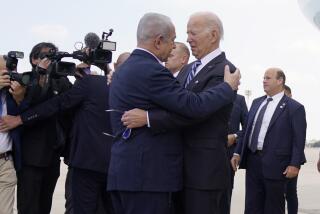Complex Struggle : Decision on SALT II Ends 5-Year Debate
- Share via
WASHINGTON — Two weeks ago, as the Administration considered whether to continue compliance with the second strategic arms limitation treaty, the ranking Soviet diplomat here was invited to the State Department to discuss a variety of outstanding U.S.-Soviet issues, including Moscow’s alleged stonewalling at the Geneva arms talks and its refusal to set a date for the next summit.
“It was a very unsatisfactory, even acrimonious, meeting, with no give by the Soviets,” one U.S. official said Wednesday. “After that, although (Secretary of State George P.) Shultz wanted continued compliance (with the treaty), he could not argue that renouncing SALT II would harm prospects for the summit or ruin chances for progress at Geneva.”
Soon after, on May 27, President Reagan made the decision that formally ended the U.S. policy of complying with the 1979 arms agreement, a decision that is potentially the most fateful arms control move of the Reagan presidency.
It immediately shocked allied countries, Congress and the Soviets, because it ended the formal framework within which offensive nuclear weapons have been constrained. Virtually everyone had assumed, based on an earlier, tentative Administration decision, that U.S. compliance would continue.
The decision also shocked the U.S. government because it was taken without a formal meeting of the President’s senior arms control advisers. Instead, one official complained, the Administration simply solicited their views by letter.
In this way, the White House staff avoided further face-to-face arguments before the President between Shultz and Defense Secretary Caspar W. Weinberger, among others, on the issue. But, in so doing, it cast doubt on the future of the arms control process within the government.
Not the Explanation
However, focusing on a single acrimonious exchange between U.S. and Soviet officials is too simple to explain the last days of SALT II, according to several U.S. officials. “A complex interplay of issues, timing and personalities went into that decision,” one senior U.S. official said.
“The Soviets gave Shultz no help in making the case for continued compliance,” said another, “but this decision has been building up through the 5 1/2 years of this Administration.”
The SALT II agreement was negotiated by the Jimmy Carter Administration. When signed in 1979, it was to have lasted until the end of 1985, but it was never ratified. In the face of determined opposition in the Senate, it was withdrawn from consideration in 1980 after the Soviet invasion of Afghanistan.
Reagan campaigned for the presidency against the agreement, branding it “fatally flawed.” But, once in office, he agreed to a “no-undercut” policy, promising to abide by its provisions as long as the Soviets showed equal restraint.
Acknowledging Reality
In part, he was bowing to the wishes of European allies and Congress, and in part he was acknowledging that, in the absence of treaty restraints, the Soviets could increase their missile arsenal faster than the United States, which he contended had become strategically inferior to its superpower rival.
But, in 1983, the Administration began issuing “non-compliance reports” that charged the Soviets with violations of virtually all U.S.-Soviet arms agreements, including SALT II and the 1972 Anti-Ballistic Missile (ABM) Treaty. The Soviets deny all the charges, most important of which are three:
--Construction of two new intercontinental ballistic missiles (ICBMs), the SS-25 and the SS-24, when only one is permitted by SALT II.
--Excessive encoding of the telemetry signals radioed from test missiles to the ground that tells engineers how well the missile is performing.
--Construction of a massive phased-array radar station at Krasnoyarsk, deep inside Siberia, in violation of the ABM treaty, which permits such radar only on the periphery of a country, oriented outward.
Evidence Disputed
Evaluating U.S. charges, some arms control experts dispute the Administration’s evidence on the SS-25. But Kenneth Adelman, director of the U.S. Arms Control and Disarmament Agency, said all U.S. agencies now are unanimous that this missile is a violation. With the excessive encryption, the Soviets appear to be taking advantage of a loophole that they succeeded in writing into SALT II. However, even ardent arms control champions acknowledge that Krasnoyarsk is a blatant Soviet violation of the ABM treaty.
Against this background, the inconsistency of the Administration’s continuing to abide by an unratified agreement, which the President had denounced and which the Soviets were allegedly violating, grew more striking with time.
Last June, the Administration for the first time faced the issue directly when, to remain within SALT II limits, the United States had to dismantle older missile-carrying Poseidon submarines to permit new, larger Trident submarines to go to sea.
In making this decision to “go the extra mile” to preserve SALT II, however, Reagan warned that he might decide differently in the future unless the Soviets met three conditions-- halting their military buildup, stopping cheating on past agreements and agreeing to substantial progress in the arms talks.
Conditions Not Met
The same situation arose this spring when a new 24-missile Trident prepared to go to sea and two older, 16-missile Poseidons faced the scrap heap if the United States were to stay under the limit of 1,200 multiple-warhead missiles allowed both sides under SALT II.
While contending that none of the conditions he had imposed had been met by the Soviets, Reagan seemed nonetheless willing to go along with SALT II once again, at least initially, this spring.
As outlined by senior officials, the President tentatively decided in April to dismantle the two older submarines and to ask Congress to increase U.S. offensive strength (such as building 100 instead of 50 MX missiles).
In consulting allies, the President took the position that another “milestone” in SALT compliance would arise in the fall or winter when the 131st B-52 bomber with cruise missiles was deployed; that bomber would violate the SALT II limit of 1,320 missiles and bombers with multiple warheads and/or cruise missiles.
‘Position Was Mushy’
“His position was mushy about the next decision on the bomber,” a senior official said. “Certainly, it didn’t imply that he would make any decision different from continued restraint.”
The President’s two chief arms control advisers, Ambassadors Paul H. Nitze and Edward Rowny, reported the favorable allied reaction to this position before the Tokyo economic summit in late April. But the President made no final decision on how to proceed.
Instead, in mid-May, a draft presidential statement, “even mushier than the first,” was circulated to the Senior Arms Control Group, and five of its members--Shultz, Weinberger, Rowny, Adelman and CIA Director William J. Casey--were asked to comment in writing.
Shultz’s response, reportedly written by Nitze, endorsed the initial position of remaining within SALT II. But Weinberger, Rowny and Casey urged that the decision to deploy the 131st bomber with cruise missiles be taken now, rather than deferred, and that the United States declare it was no longer bound by SALT II, officials said. Conservative senators helped lobby on behalf of the majority.
No More Meetings
Contrary to previous practice, no further SACG meetings were held. Instead, the President’s national security adviser, Adm. John Poindexter--reportedly with the encouragement of White House chief of staff Donald T. Regan--rewrote the President’s statement, as urged by the more conservative Cabinet officials.
“That process was quite different than under Bud McFarlane (Robert C. McFarlane, Poindexter’s predecessor), who set up the SACG,” one official said, “and it is creating a lot of anxiety in the State Department about the future of the arms control process.”
The President’s decision, as finally disclosed May 27, consisted of three main points:
--The two submarines will be dismantled, on grounds of age and overhaul costs rather than in compliance with SALT II. Nonetheless, as Reagan said, this keeps the United States “in technical compliance” with SALT II’s numerical ceilings.
New Policy
--As a new policy, the United States is no longer restrained by the limits on offensive strategic arms contained in SALT II. Instead, it will determine how many weapons to deploy based on “the nature and magnitude” of the Soviet threat.
--The United States will deploy B-52s with cruise missiles beyond the 131st aircraft without dismantling other systems to stay in compliance with SALT II. This could breach the pact’s ceilings in November.
If the Soviets “take constructive steps” to change the reasons for Reagan’s decision, the United States “will certainly take this into account,” the President said.
More to Read
Get the L.A. Times Politics newsletter
Deeply reported insights into legislation, politics and policy from Sacramento, Washington and beyond. In your inbox twice per week.
You may occasionally receive promotional content from the Los Angeles Times.










